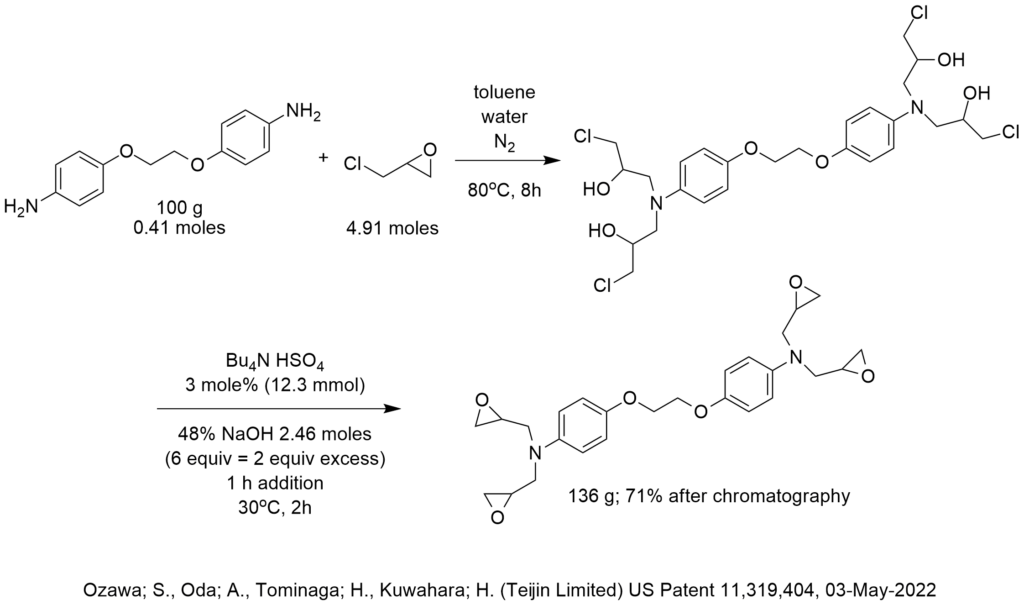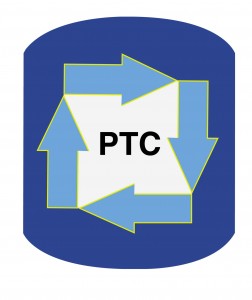Several tetraepoxides were synthesized in this patent for the production of cured resin products with many advantages (high water absorption resistance, high elastic modulus, high impregnation property into a reinforcing fiber base material, excellent handleability). The diagram shows one of the tetraepoxides produced.

The epoxides were formed in 2 stages. In the first step, the diamine was reacted with epichlorohydrin to form the tetrachlorohydrin. In the second step, PTC was used to close the chlorohydrin back to the epoxide ring.
In other PTC reactions of epichlorohydrin, such as in the production of glycidyl ethers and glycidyl esters, one can perform the reaction in one step. In those cases, the base can first deprotonate an alcohol to an alkoxide or deprotonate a carboxylic acid to a carboxylate anion, then the anions attack the epichlorohydrin. In the case of the reaction of amines with epichlorohydrin, it is speculated that since the N-H group is not easily deprotonated, the nucleophilic attack of the nitrogen on the epichlorohydrin may need to be performed first, regardless of the presence of base. If so, then PTC is useful only for the ring closure with base in the reaction shown in the diagram.
PTC Organics has specialized expertise in performing reactions with epichlorohydrin (including PTC Organics’ trade secret technology for certain applications). If your company needs to achieve low-cost high-performance green chemistry reactions using epichlorohydrin, now contact Marc Halpern of PTC Organics to explore collaboration for commercializing advantageous PTC technology.
About Marc Halpern

Dr. Halpern is founder and president of PTC Organics, Inc., the only company dedicated exclusively to developing low-cost high-performance green chemistry processes for the manufacture of organic chemicals using Phase Transfer Catalysis. Dr. Halpern has innovated PTC breakthroughs for pharmaceuticals, agrochemicals, petrochemicals, monomers, polymers, flavors & fragrances, dyes & pigments and solvents. Dr. Halpern has provided PTC services on-site at more than 260 industrial process R&D departments in 37 countries and has helped chemical companies save > $200 million. Dr. Halpern co-authored five books including the best-selling “Phase-Transfer Catalysis: Fundamentals, Applications and Industrial Perspectives” and has presented the 2-day course “Practical Phase-Transfer Catalysis” at 50 locations in the US, Europe and Asia.
Dr. Halpern founded the journal “Industrial Phase-Transfer Catalysis” and “The PTC Tip of the Month” enjoyed by 2,100 qualified subscribers, now beyond 130 issues. In 2014, Dr. Halpern is celebrating his 30th year in the chemical industry, including serving as a process chemist at Dow Chemical, a supervisor of process chemistry at ICI, Director of R&D at Sybron Chemicals and founder and president of PTC Organics Inc. (15 years) and PTC Communications Inc. (20 years). Dr. Halpern also co-founded PTC Interface Inc. in 1989 and PTC Value Recovery Inc. in 1999. His academic breakthroughs include the PTC pKa Guidelines, the q-value for quat accessibility and he has achieved industrial PTC breakthroughs for a dozen strong base reactions as well as esterifications, transesterifications, epoxidations and chloromethylations plus contributed to more than 100 other industrial PTC process development projects.
Dr. Halpern has dedicated his adult life to his family and to phase-transfer catalysis (in that order!).


